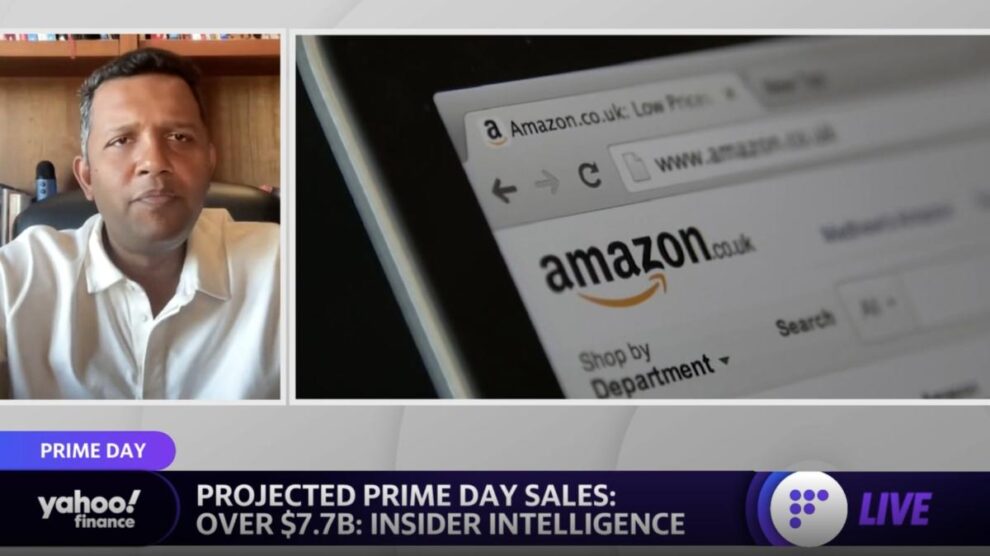Former Amazon executive and CommerceIQ CEO Guru Hariharan examines the economic significance of Prime Day sales amid inflation, as well as consumer sentiment, inventory deals, and e-commerce.
Video Transcript
[MUSIC PLAYING]
DAVE BRIGGS: All right. We’re continuing to break down all things Amazon Prime Day. And research firm insider intelligence estimates sales for the two-day event could climb over $7.7 billion in the US alone. That’s over 16% higher than last year. But some experts are questioning whether the event is actually running out of steam.
Guru Hariharan is joining us now. He is the CEO of Commerce IQ, a former manager for Amazon Seller Services and Head of Amazon Development Center at Phoenix. Nice to see you, Guru. So Amazon, how different a place are they in now than prior years? And I’m not talking pre-pandemic, but just the last year or two?
GURU HARIHARAN: Dave, first of all, thanks for having me. Amazon is sort of going through a big transformation right now, right? Like they’ve got a new– brand new management team, lots of changes in the retail business. Their AWS business continues to drive in different directions and go from strength to strength. It’s, frankly, the margin driver for them.
And the other category, which sort of reports the retail media piece, that’s been driving pretty effectively. So Amazon is no longer just a retail store anymore. In fact, a lot the profits are coming from the other angles.
But if you look at specifically Prime Day, this is a very interesting Prime Day for, I would say, for the economy. The reason being, it is the tip of the spear of consumer sentiment. Like if Prime Day is going to be successful this year, which means that the consumer sentiment is high, which then means that the economy is sort of like– is also on the right path.
On the other hand, if we see that the Prime Day is going to be lackluster, it will indicate that the consumer sentiment is starting to become low, and potentially it may have– it may end up being the bellwether for a recession that we’re probably sitting on top of.
So it’s going to be very interesting to see how the Prime Day mechanics or consumers behave and shop on Prime Day. And that will be the bellwether for the world economy, I would say, because of that transitive– the transitionary nature of how this– how all of this is indicative of the economy.
RACHELLE AKUFFO: And to that point, I mean, Prime Today is happening in over 20 countries this year, including Poland and Sweden for the very first time this year. But what does this mean in terms of some of these supply chain bottlenecks that we were seeing?
GURU HARIHARAN: Yeah. So Rachelle, supply chain is a major issue right now. And it is going to continue to be one for the next five years. Just in the last one year alone, we are seeing about a 45% increase in replenishable out of stocks, which is out of stocks.
That is, if you or I– what that means is if you or I go to amazon.com and are looking for a product it, especially in something in say, a category like replenishable categories like, say, a diaper or paper tissues and things like that, that specific– those purchases, we are not finding those items about 5% of the time.
So it used to be 4% of the times. That out-of-stock nature has gone up about 100 basis points year over year. This is from last May to this May, as data suggests from Commerce IQ customers.
And if you look at the global supply chain crisis, obviously, the war has had a pretty deep impact on a lot of categories, especially food. And we are going to continue to see the impact of that in this Prime Day as well.
SEANA SMITH: Guru, I’m curious. Because when it comes to Prime Day, you see a lot of these lightning deals. Obviously, that’s encouraging consumers to take advantage of the deals right now and spend in that short time frame. From the data that you’ve seen, how, I guess, successful or how effective are these types of deals in getting consumers to spend right away?
GURU HARIHARAN: So it used to be a game of deep discounts and broad discounts. Let’s say, when Prime Day was still new, there was a lot of shine on the ball and all of that. Over the last few years, what we have seen, Seana, is that it has reduced in terms of the number of amount of sales that has happened in just one day compared to an average day.
It used to be around 3x– we used to see about 3x higher sales. There was a lot of shine on the ball, a lot of excitement with Prime Day. Last year it was– it went down from 3x to 2 and 1/2 x on an– of– as compared to an average day.
This year, we are sort of seeing that to be more of the case of being of that downward trend. Of course, I’m– I hope I’m wrong and I can– I would love to be surprised in the other way. But we expect the sales to be more around 2x a normal day as opposed to what it was 3x two years ago.
Now, from a discounting perspective, we are not seeing very broad discounts anymore. These are going to be very much specific products, specific discounts. As you mentioned, consumers should watch for lightning deals, for featured products, and things like that. We have also seen discounts more prevalent in categories like home and kitchen, and patio lawn and garden way more than, let’s say, grocery, or pet, or home and personal care, what used to be pretty dominant in the prior days.
DAVE BRIGGS: And Guru, circling back to your initial point about this being the tip of the spear of consumer sentiment. But we’ve already seen e-commerce as a percentage of total US sales really flatline in recent months. Don’t we already know that consumer spending has really shifted away and now is towards things like services?
GURU HARIHARAN: Yeah. So if you look at the consumer behavior, what we are seeing is the total– we got a– we had a huge bump in e-commerce percent of total retail during the pandemic. This is when, if you remember, we were not– we were in lockdowns. We were not able to go out and drive cars and stuff like that. E-commerce as of total retail was close to or even above 30% at that time. A lot of critics expected that it will come back to a 15% after that.
But what we saw was, actually, it settled down at between 20% to 25%. Which is today, if you look at retail dollars that are flowing through the economy, between 20% to 25% of our sales are happening on e-commerce. So it settled down at a higher plateau than what we would have gotten to in a very organic way absence of the pandemic. So in a lot of ways, huge tailwinds if you look at a three to four year period.
But of course, in the last two years, expecting the unexpected has been the norm. And hence, things have been up and down, whether it’s because of consumer behavior, whether it’s because of inflation, whether it’s because of consumer confidence, we don’t know. There are lots of factors that impact that.
But at the same time, we are definitely seeing consumer behavior to have irreversibly shifted in a lot of cases to shop more online. Think about your own purchase behaviors. How often now are you shopping on, say, Instacart, and Amazon Fresh, and Grocery Outlet, and things like that as opposed to, say, going to a store.
RACHELLE AKUFFO: Yeah. I know it’s certainly changed for me. We do appreciate you joining us today, Guru Hariharan, Commerce IQ CEO and a former executive at Amazon. Thank you for your time today.







